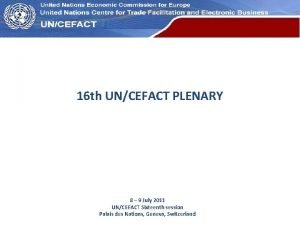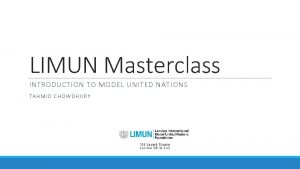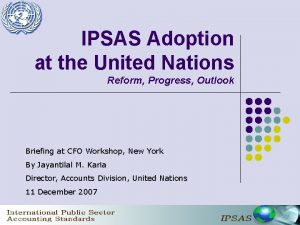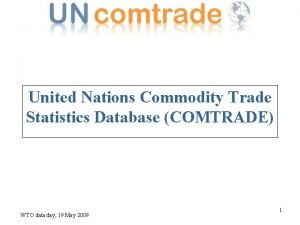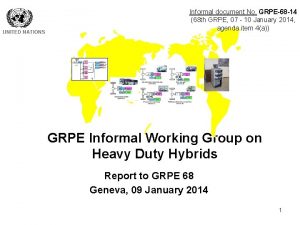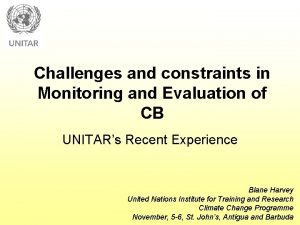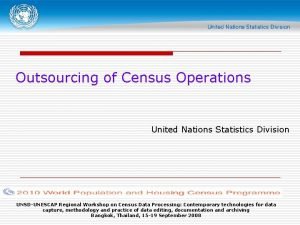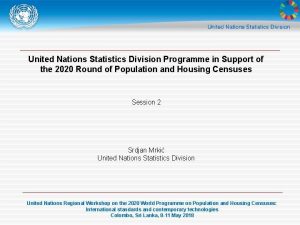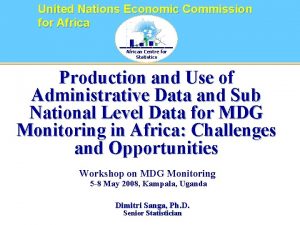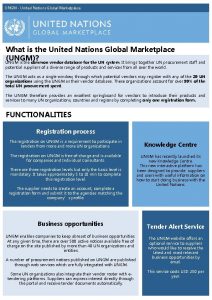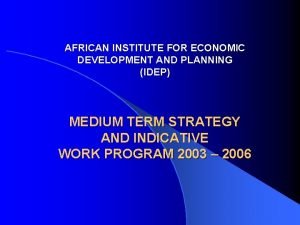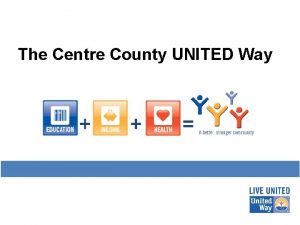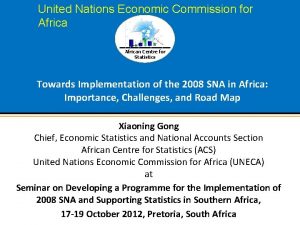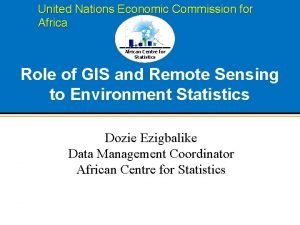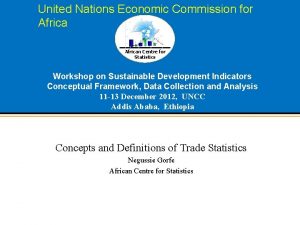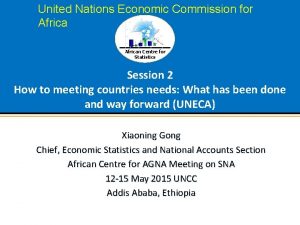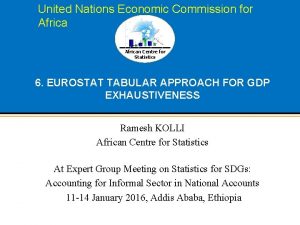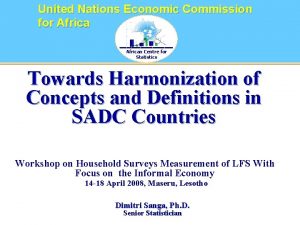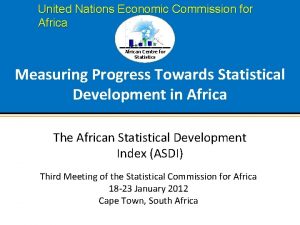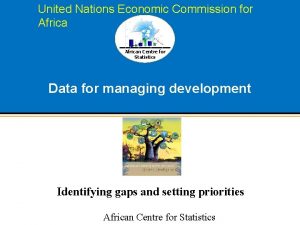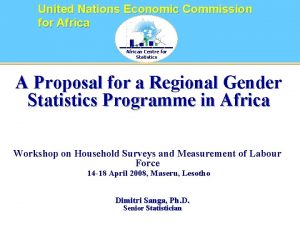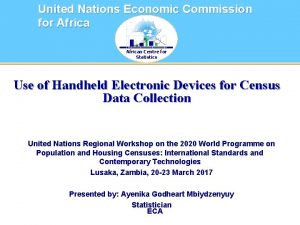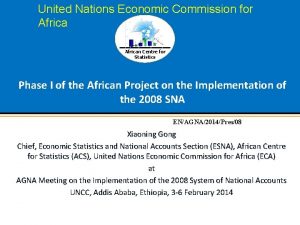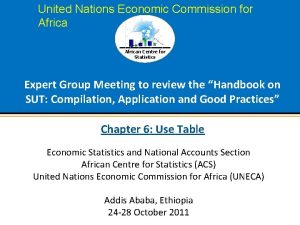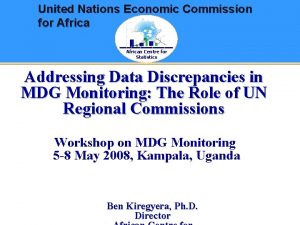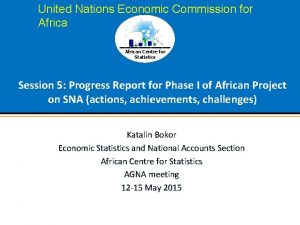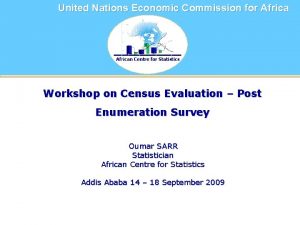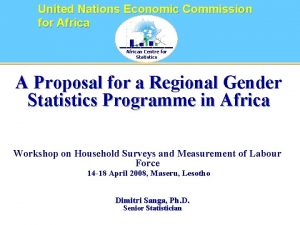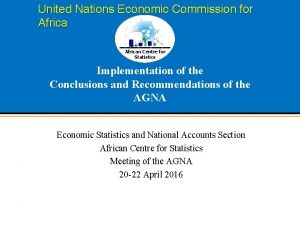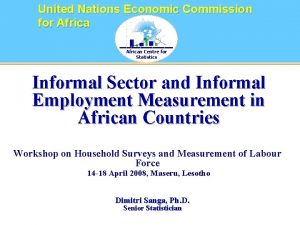United Nations Economic Commission for African Centre for



































- Slides: 35

United Nations Economic Commission for African Centre for Statistics Integrating Agricultural Statistics into National Strategies for the Development of Statistics (NSDS) Ben Kiregyera Director African Centre for Statistics 4 th ICAS, Beijing, China 22 – 24 October

Outline I. Introduction II. NSDS and its Processes III. Integration of Sectoral Statistics into NSDS IV. Conclusions Slide 2

Motivation Issues which have come up during this conference: q organizational issues (including, mandates, coordination, etc) q institutional issues (including infrastructure, funding, HR, capacity building, etc) q data-related issues (data sources, data collection methodologies, data management including dissemination) Many of these issues are best handled as part of broader frameworks and initiatives e. g. National Strategy for the development of Statistics Slide 3

I. Introduction

Public management approaches q Last 40 years or so pressure on governments around world for greater transparency & accountability in use of public resources This led to emergency of different public sector management approaches § § 1960 s approach: Emphasis on financial planning & cost accounting 1970 s & 1980 s approach: Emphasis on management - by- activity From mid-1980 s: Management - by - objectives From 1990 s: Emphasis on managing for results with a focus on achieving outcomes - defined as medium term effects or results of development intervention (OECD) Slide 5

Managing for results q Managing for results has evolved as a global effort among both national governments and development agencies to: § reduce poverty (headline MDG goal) § support sustainable and equitable economic growth § better define and systematically measure development outcomes § report on achievements of outcomes and impact of polices and programmmes Slide 6

q statistics is not only a technical issue BUT also a development issue q results agenda requires that: • data producers understand talk more and more about development policies and issues & • policy and decision-makers understand talk more and more about statistics all in pursuit of development outcomes Slide 7

“If you can’t measure it, you can’t manage it” or “That which gets measured gets done” q Managing for results is “data intensive” Slide 8

q Agriculture Education Health etc… Some current data needs Macroeconomic framework Sectoral Policies & Programmes New challenges Human Rights and Freedom Democracy and Good Governance HIV/AIDS Surveillance Gender Energy and Environment Policy Research & Research Agenda Needs Slide 9

Statistics in developing countries Various assessments Results Slide 10

q Many countries face the twin problem of inadequate data demand supply High Demand II “Data Supply-constrained countries” Poor Quality I “Vicious Circle countries” IV “Virtuous Circle countries” III Good Quality “Data Demand-constrained countries” Low Demand Slide 11

q Characteristics of statistical under-development § Inadequate statistical awareness/literacy § inadequate links of statistical systems to policy processes § lack of statistical plans (or vicious statistical plans which are NSO-centric, typical handwork of statisticians) § § § lack of coordination (next slide) § § § weaknesses in statistical capacity data gaps on some key demographic, socio-economic and environmental indicators unreliability of some existing data inadequate use of existing data – challenge of data use unsustainability of statistical systems Slide 12

Uncoordinated National Statistical System Agriculture etc Health NSO Transport Labour Education Slide 13

Partially coordinated National Statistical System Agriculture etc Health NSO Transport Labour Education Slide 14

Fully coordinated National Statistical System Agriculture etc Health NSO Transport Labour Education Slide 15

Irony: Countries that need statistics most are the ones that purportedly are least able to afford them Slide 16

q Consequences of the said statistical underdevelopment: § policy & decision-making have suffered § proper allocation and targeting of resources and programmes has been hampered § citizens have not been enabled to make informed choices § governments have not been held to account for their decisions People are the poorer Slide 17

q PARIS 21 and partners have been making the case for countries and partners to invest in statistical development: § statistics are a public good and part of the development infrastructure § investment in statistics pays for itself many times over by improving how resources are allocated § Various roundtables on managing for results have identified statistics as a priority for the results agenda § Marrakech Roundtable (2004) adopted the Marrakech Action Plan for Statistics (MAPS) to improve national and international statistics Slide 18

q Marrakech Action Plan for Statistics builds on existing initiatives and experiences q sets out 6 sets of actions needed to improve statistics at national and international: 1. Mainstream strategic planning of statistical systems and help all low-income countries prepare national statistical development strategies by 2006 2. Strengthen preparation for 2010 census 3. Increased financial support for statistical capacity building 4. Set up an international household survey network. 5. Undertake urgent improvements needed for MDG monitoring for 2005 6. Increase accountability of the international statistical system Slide 19

II. NSDS and its processes Slide 20

National Strategy for the Development of Statistics System-wide national strategy and plan of action q q q A catalyst for change to build confidence to strengthen statistical capacity across the entire National Statistical System A medium to long-term vision for SCB responding to key user needs A robust, comprehensive and coherent framework to: ü address data limitations ü mobilize & prioritise the use of resources ü integrate statistics within national policy, planning & budget processes Slide 21

q Importance of the process ü as important as the strategy ü facilitate statistical advocacy ü mainstream key stakeholders i. e should: v be participatory v be inclusive v use a concensus-building approach • Plans that are country-specific and countryowned • Ownership leads to more commitment, creativity, imagination, innovation and productivity. ü participation and ownership are essential for successful strategic management and the key to the success of any development strategy Slide 22

ü process presupposes that we are aiming to build a truly integrated National Statistical System ü process should be based on NSDS principles developed by PARIS 21 and partners ü Guide on Design of NSDS published by PARIS 21 (2004) ü Some Issues in the Design and Implementation of NSDS by PARIS 21 (2006) ü Guide on Integrating Sectoral Statistics in the Design of NSDS (Af. DB, PARIS 21 and Intersect) Slide 23

q Methodology 2. WHERE DO WE WANT TO BE? 1. WHERE ARE WE NOW? 2. Current situation Mission/vision Statistical capacity 4. HOW DO WE STAY THERE? Sustainability 3. HOW DO WE GET THERE? Strategies/Actions Slide 24

III. Integration of sectoral statistics into NSDS Slide 25

Rationale for integration q a lot of development data are collected/compiled by sectors ü Agriculture ü Health ü Education ****** ü Labour q sectoral issues and concerns not been given sufficient attention in national statistics q statisticians from line ministries been largely isolated & inadequately involved in discussion on capacity building q sectoral component of NSS tended to be under-resourced & is in need of more voice in sectors and in NSS Slide 26

Bottom-up approach NSDS SSPS (Agric) SSPS (Health) SSPS (Edn. ) SSPS – Sector Strategic Plan for Statistics Slide 27

Assessment of state of sectoral data Using Health Matrix Network Framework Resources Policies; Financial resources; Human resources; Communication; Coordination and leadership Indicators Minimum set of indicators Data sources Types of data sources and standards Data management Data definition; flow; quality; storage; linkage Information products Users requirements; analysis; presentation Dissemination and use Infrastructure; synthesis; packaging; communication Slide 28

Components Framework applies to all sectors Agriculture Education Labour Health etc Resources Policies; Financial resources; Human resources; Communication; Coordination and leadership Indicators Minimum set of indicators Data sources Types of data sources and standards Data management Data definition; flow; quality; storage; linkage Information products Users requirements; analysis; presentation Dissemination and use Infrastructure; synthesis; packaging; communication Slide 29

Sectors Cross-sectoral requirements Agriculture Education Labour Health etc Decisions made in this sector that require data from other sectors: q What data/indicators? q Which sectors? q What products? Data that are or should be shared with other sectors? q What data/indicators? q Which sectors? q What products? Slide 30

Component Opportunities to coordinate Agriculture Education Labour Health etc Resources Harmonize policies and budgets Coordinate training/allocation of human resources Build communities of practice Rationalize the use of information technology Indicators Identify and standardize common indicators Data sources Synchronize surveys and routine data collection Data management Link data dictionaries and warehouses Build consistent data quality Coordinate data transmission Information products Analyze and present data across sectors Synchronize reports for the same users Dissemination and use Advocate with one voice Coordinate evaluation across sectors Slide 31

Resulting NSDS will: q include a synthesis of sector plans § buy-in by sectors § ownership – one of prerequisites for effective implementation “People support what they help to create” q promote policies that lead to greater harmonization across sectors during the course of the plan implementation q lead to coordination of all statistical functions across organizations and sectors Slide 32

Critical success factors q Strategic leadership and management (strategic insight) q NSDS not just one of the statistical activities q Statistical reform (not cosmetic) q Managing change “It’s not the strongest species that survive, nor the most intelligent, but the most responsive to change”, Charles Darwin – father of evolution theory q Process (participatory, continuity, empowering, involve development partners from start) q Coverage of all sectors q Cultivate “Champions” and “Missionaries” q Partnerships (nationally, regionally & Internationally) Slide 33

IV. Conclusions q Managing for results has increased exponentially demand for data q In many countries, national statistical systems caught up in a vicious circle of underdevelopment and under-performance q Poor countries have been urged to develop NSDS q The NSDS should be designed in such a way as to integrate sectoral issues and concerns q Best achieved using a bottom-up approach Slide 34

Thank you! African Centre for Statistics Visit us at http: //www. uneca. org/statistics / Slide 35
 United nations economic commission for europe
United nations economic commission for europe African nations gain independence
African nations gain independence Introduction to model united nations
Introduction to model united nations Ipsas united nations
Ipsas united nations United nations commodity trade statistics database
United nations commodity trade statistics database United nations
United nations United nations
United nations United nations basic principles on the role of lawyers
United nations basic principles on the role of lawyers Six main organs of the united nations
Six main organs of the united nations United nations flag
United nations flag Monitoring and evaluation challenges
Monitoring and evaluation challenges Opsp united nations
Opsp united nations Unicef is mandated by the united nations general
Unicef is mandated by the united nations general United nations
United nations Introduction of un
Introduction of un Model united nations
Model united nations United nations statistics division
United nations statistics division Role of united nations
Role of united nations United nations statistics division
United nations statistics division United nations convention on the carriage of goods by sea
United nations convention on the carriage of goods by sea United nations zambia
United nations zambia United nations
United nations What is undss
What is undss United nations road safety
United nations road safety The agency sponsored by the united nations that compiles
The agency sponsored by the united nations that compiles Anatolia college mun
Anatolia college mun Ethics and integrity at the united nations
Ethics and integrity at the united nations Aitor arauz chapman
Aitor arauz chapman United nations
United nations Uno flag
Uno flag What is ungm
What is ungm Christian saunders united nations
Christian saunders united nations African institute for economic development and planning
African institute for economic development and planning Sections 1-6 1-7 commission and graduated commission
Sections 1-6 1-7 commission and graduated commission Secondary education commission mudaliar commission
Secondary education commission mudaliar commission Centre county united way
Centre county united way
